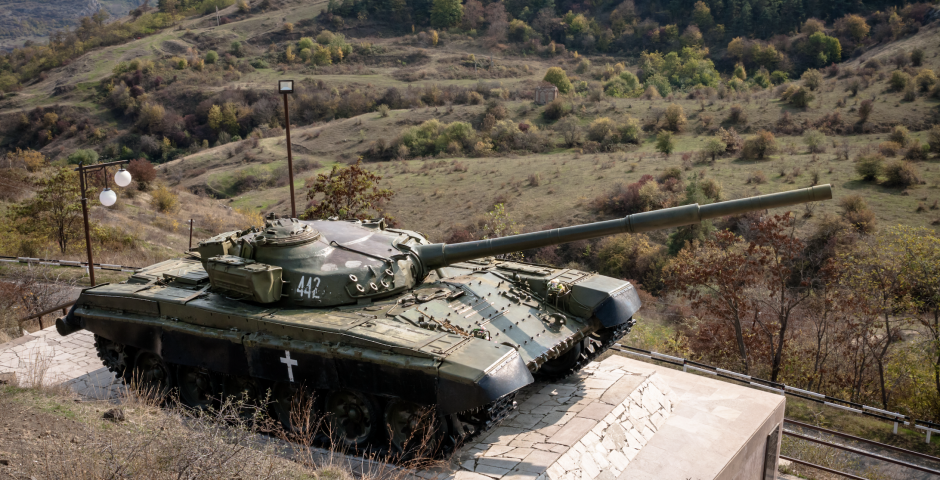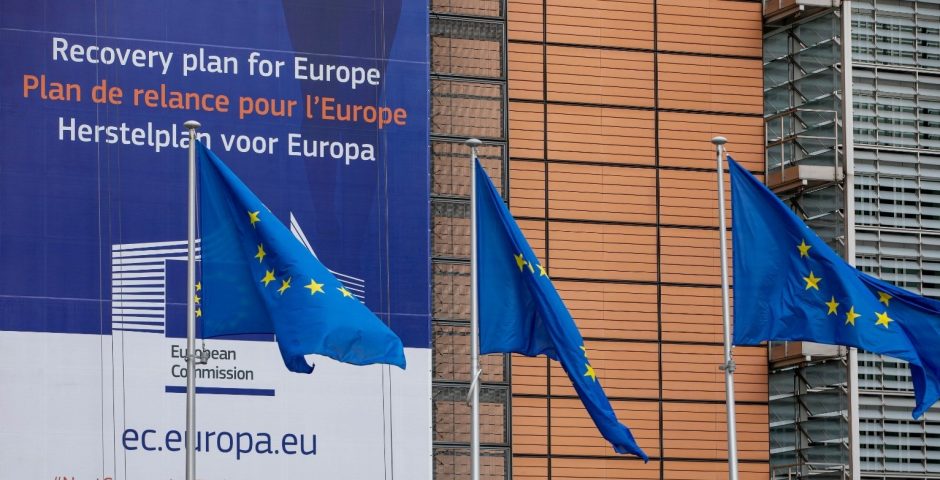Long read: Brussels and the Caucasian Knot

Why the EU should get involved in peace building between Armenia and Azerbijan.
After 44 days of intense fighting between Armenian and Azerbaijani forces, silence fell over Nagorno-Karabakh. In accordance with a ceasefire agreement brokered by the Russian Federation roughly 70 percent of the territory of the self-proclaimed Republic of Artsakh was to be turned over to Azerabaijani authorities. With much of its territory lost in the peace agreement, the Republic of Artsakh would remain connected to the Republic of Armenia through the already existing Lachin Corridor. After being used as the main artery for travel and trade between Armenia and Artsakh, the highway to Stepanakert now represents a crucial lifeline for a devastated and depopulated land. Additionally, a terrestrial connection would be established between Azerbaijan and its exclave of Nakhchivan through Armenia’s southern region of Syunik. While it seems that this would likely be achieved through the construction of a highway through Armenia that would be monitored by the Russian military, the immediate specifics of this clause were not clear and some commentators speculated that this would entail effectively ceding portions of Armenia’s southern frontier with Iran.
All of the clauses of this drastic reshaping of Eurasia’s oldest frozen conflict zone would be facilitated by the deployment of a Russian peacekeeping mission, the purpose of which would be to observe the transfer of territory from the Republic of Artsakh to Azerbaijan and to monitor the newly demarcated state borders of Armenia and Azerbaijan. While this mission is granted a five year mandate, a clause allows for its automatic extension so long as neither Armenia nor Azerbaijan object towards a long-term deployment. When we consider the longevity of Russia’s peacekeeping operations in the breakaway territories of Transnistria, Abkhazia, and South Ossetia, and the role that these peacekeeping missions play in Russian foreign policy, we can assume that the Russian military will remain in Nagorno-Karabakh for the foreseeable future.
Find a map of the current territory of the Republic of Artsakh/Nagorno-Karabakh after the implementation of the November 9th Peace Agreement here.
From the start of hostilities in late September to the concluding peace agreement, the European Union was noticeably absent on matters related to Nagorno-Karabakh. Even with demonstrations throughout Europe by members of the Armenian diaspora while individual member states and certain chambers of government voiced their stance on the conflict, Brussels’ response was largely limited to representatives calling for an immediate end to the fighting, applauding shaky ceasefires, and imploring both Armenia and Azerbaijan to mutually respect pre existing principles for mediation and dialogue. Considering the EU’s relationship with both Armenia and Azerbaijan and its interest in promoting peace in its immediate neighbourhood, Brussels’ lack of meaningful response to the conflict reflects some deficiency in the Common Foreign and Security Policy. With an uneasy and tense peace falling over the region it is crucial that the European Union shows initiative in engaging with the ongoing peace process in Nagorno-Karabakh and presents itself as a relevant actor in the South Caucasus. This article will explore the relevance of the 2020 Karabakh War to the European Union and will close with broad recommendations on how the EU should adapt and reassert its presence in the region.
Nagorno-Karabakh and the EU
At the core of the Nagorno-Karabakh conflict is a clash between the concepts of territorial integrity and self-determination. During the waning years of the USSR, the Armenian-majority population of the Nagorno-Karabakh Autonomous Oblast (NKAO) pushed for independence from the Azerbaijan SSR. Referendums on the topic of separation from the Azerabaijani SSR and declarations of independence by the NKAO were repeatedly struck down. Anti-Armenian pogroms in the cities of Baku and Sumgait demonstrated not only the rapidly deteriorating sense of stability and interethnic peace in Azerbaijan, but also the lack of interest from the Azerbaijani government in protecting its Armenian population. By 1992 the political dispute over the status of NKAO, which had begun to refer to itself as the “Nagorno-Karabakh Republic” (NKR), had grown into a full conflict between Armenian militias and the state of Azerbaijan. The mass murder of civilians by Armenian militias in 1992, known as the Khojaly Massacre, demonstrated a mutual capacity for cruelty in the conflict and further solidified the deep distrust between Armenian and Azerabijani communities. By late 1992 much of the Azerbaijani and non-Armenian population of the NKR had been displaced, and with the intervention of the Armenian military in defence of the NKR the dispute had officially grown into an inter-state conflict.
After a ceasefire in 1994, Armenia and Azerbaijan would spend almost 30 years locked in a simmering, low-intensity war with one another. This unresolved conflict would come to shape the politics of both countries as questions of national security would remain the greatest policy concern. Both states would continue policies of mandatory conscription to meet the security challenges posed by the conflict, while the blockade of land-locked Armenia by Azerbaijan and Turkey (a close ally of Baku) would funnel almost the entirety of Armenia’s trade through neighbouring Georgia. The status-quo of this conflict would be punctuated by major clashes, such as the 2016 Four Day War, but the notion of a return to large-scale fighting seemed unrealistic.
The European Union has held bilateral relations with both Armenia and Azerbaijan since their declarations of independence from the Soviet Union. Armenia, Azerbaijan, and neighbouring Georgia make up half of the European Union’s “Eastern Partnership” (EaP) initiative. The EaP is designed to foster the integration and deepening of relations between the European Union and six former republics of the Soviet Union, albeit without the guarantee of future membership. In pursuing a closer relationship with the European Union, the three states of the South Caucasus have taken diverging paths. Georgia is vocally committed to future membership in both the European Union and NATO and formally holds the title of “Associate of the European Union”. The Georgia-EU Association Agreement and the Deep and Comprehensive Free Trade Agreement form the legal basis of this relationship and Georgia often looks to Brussels as a potential counterweight against aggression from the Russian Federation. Armenia’s political interests with the European Union are often constrained by the realities brought about by the Nagorno-Karabakh conflict and its associated developments – such as the aforementioned blockade by Azerbaijan and Turkey. While Armenia was due to sign an association agreement with the European Union similar to that of Georgia, this was cancelled due to pressure from the Russian Federation. Armenia would instead pursue membership in the “Eurasian Economic Union” (EAEU) – a grouping of five former Soviet Republics with its own competing market and legal structures similar to those of the European Union.
After the annexation of Crimea, the multiple rounds of sanctioning between Russia and the European Union, and the subsequent political fallout between Brussels and Moscow, Armenia would revisit its relationship with the European Union. In 2018 Yerevan would ratify a revised version of its forgone EU Association agreement known as the “Comprehensive and Enhanced Partnership Agreement” (CEPA) drafted in late 2017. This agreement was designed to salvage all the clauses related to political cooperation and legal integration while omitting any elements that would conflict with Armenia’s EAEU membership. Armenia-EU relations would enter a honeymoon period after the passage of CEPA, particularly after the Velvet Revolution. Given the peaceful transition of power following the Velvet Revolution, the ongoing process of democratization, and Yerevan’s novel model of EU integration, Armenia was considered by some in Brussels to be a new model of engagement with the post-Soviet space. Unlike Armenia and Georgia, Azerbaijan’s partnership with the European Union did not include legal approximation or the usage Association Agreements. This is partially due to Azerbaijan’s policy of strict neutrality, as well as the implications such agreements would have for Azerbaijan given Baku’s poor human rights record. Instead, Baku would shape its relationship with Brussels around the sale of natural gas and oil and position itself as a potential alternative partner to the Russian Federation in the import of energy.
With regards to the Nagorno-Karabakh conflict, the European Union officially supports the territorial integrity of Azerbaijan and has no formal recognition of the Republic of Artsakh. This position is shaped by a variety of factors. While there are nuances that separate territories like Crimea, Abkhazia, and Artsakh from one-another, the European Union will defer to the principle of territorial integrity for the sake of legal consistency and to avoid appeasing irredentist movements in the continent. Additionally, recognition (overt of implicit) of the Republic of Artsakh’s independence may give standing to independence movements in the European Union, such as those seen in Catalonia, Scotland, or Bavaria. However, this is not a carte blanche for Azerbaijan to act with impunity in Nagorno-Karabakh as the European Union regularly directs its calls for ceasefire at both parties of the conflict. The European Union has no formal form of engagement with the preexisting monitoring missions associated with the Nagorno-Karabakh conflict, nor an official role in the ongoing peace process. While European interests could be considered to be represented by France’s co-chair position in the OSCE’s trilateral monitoring mission in Nagorno-Karabakh (alongside the United States and Russian Federation), Paris is broadly considered to be supportive of Armenia in the Nagorno-Karabakh conflict.
Beyond concerns related to the intensity and length of the fighting between Armenia and Azerbaijan, the involvement of Turkey in the 2020 Karabakh War should be particularly alarming to the European Union. After years of political support for Azerbaijan’s position in the Nagorno-Karabakh conflict, Ankara directly intervened alongside Baku during the most recent period of fighting. This intervention came in the stationing of several F-16 fighters to a military airport in Ganja (one of which later downed an Armenian SU-25 ground attack craft), as well as the deployment of mercenaries and private military contractors to Nagorno-Karabakh and the supply of TB-2 drones to the Azerbaijani military. In addition to representing a direct escalation of the conflict through the involvement of an outside party, Turkey’s intervention ran the risk of potential confrontation with the Russian Federation. Given Russia’s deep security partnership with Armenia, the stationing of Russian military elements in the cities of Gyumri and Yerevan, and the tense relationship between Russia and Turkey, there was a genuine concern from outside observers that the conflict in Karabakh would become another theatre of competition for Ankara and Moscow.
A Flawed Peace
There are several potential flaws in the current ceasefire agreement. While functional in ending the immediate fighting over Nagorno-Karabakh, the current ceasefire conditions do not touch on a meaningful resolution of the conflict nor establish a long-term settlement process. Even with the cessation of hostilities both Armenia and Azerbaijan maintain the same grievances that they did entering the 2020 Karabakh War. While the handover of territory is undoubtedly seen as a major gain by Baku, Azerbaijan maintains an outstanding claim over the remaining 30% of the Republic of Artsakh’s territory. This is reflected in the rhetoric espoused by the Azerbaijani government since the ceasefire agreement, which alternates between declarations that the entirety of Karabakh has been liberated and claims of an impending reconquest of the remaining territory. Simultaneously, Armenia continues to support the Republic of Artsakh as an equal partner in the peace process, while Stepanakert maintains the same unrecognised government as it did prior to the 2020 Karabakh War. Given Azerbaijan’s status as the victor of the recent period of fighting, Baku is unlikely to entertain any negotiation or dialogue process that places it on an equal footing to Armenia. This is particularly relevant as, according to Prime Minister Pashinyan, the only alternative to the current settlement was the complete loss of the Republic of Artsakh. Today Yerevan maintains its support for Artsakh while holding even less leverage over Azerbaijan than it did prior to this fall. With an advantageous position gained from holding the city of Shushi, the open support of strategic partners like Turkey and Pakistan, and the overall success and effectiveness seen in the recent military campaign, there is no direct incentive for Azerbaijan to forgo a maximalist position in negotiations with Armenia.
The current peace agreement also directly binds the security of Armenia and Artsakh to the presence of the Russian peacekeeping mission. The danger in this arrangement comes in Russia’s vested interest in leaving the Nagorno-Karabakh conflict unresolved and in keeping Armenia’s national security in a precarious state. While Russia has repeatedly declared itself to be Armenia’s main partner in matters related to security, Moscow’s actions have contradicted this arrangement. Since 1991 Russia has been the largest arms supplier of both Armenia and Azerbaijan. Beyond consistently supplying both sides of the conflict with weapons, Moscow will often tie the sale and delivery of military hardware to the foreign policy agendas of Baku and Yerevan. In response to developments between Armenia and the European Union, Moscow authorised the sale of weapons systems to Azerbaijan and implied that the continued development of relations between Brussels and Yerevan would lead to more sales. This sale of weapons to Azerbaijan continued well after the Four Day War in 2016 and will likely continue for the foreseeable future.
Although the politicisation of weapons sales is not unique to Russia and the Caucasus, what makes this arrangement so peculiar is how politically and legally integrated Russia is with Armenia’s security infrastructure. Despite these weapons sales to Azerbaijan, Russia remains the main guarantor of Armenia’s national security. Beyond the stationing of troops in Armenia, the 1997 Treaty on Friendship, Cooperation, and Mutual Assistance outlines a mutual defence clause between both countries. However, even when the territory of Armenia-proper has come under attack during skirmishes and the clauses of the 1997 treaty have been directly evoked, Russia has not delivered on its role as a security provider. Given that Russia is the main deterrent towards further aggression from Azerbaijan towards Armenia, it is unlikely that Yerevan will seriously consider diverging from this security partnership. Similarly, given that the peacekeeping mission is due for automatic renewal every five years so long as long as there is no objection from either Armenia or Azerbaijan, it is in Russia’s interest to create conditions where Baku considers the mission necessary for its own national security interests. Should Armenia deepen relations with the European Union in the future, it is entirely possible that Moscow could use the withdrawal of its peacekeeping force in the Republic of Artsakh as a bargaining chip.
Reentering and Re-Engaging the Region
Unfortunately, the European Union’s passive response to the crisis has placed it in a less than advantageous position. In order to contribute to the development of a lasting peace in Nagorno-Karabakh, and restore the image of the EU as a decision maker with agency in the eyes of Baku and Yerevan, there are certain policy objectives that must be delivered by Brussels. It is crucial that monitoring and peacekeeping are neither monopolised by one party nor used as a means of political manoeuvring in a great power conflict. Elsewhere in the region, the European Union has already acted in the role of an observer and monitor. This was achieved through the European Monitoring Mission to Georgia (EUMM). While acting in the Republic of Artsakh may be legally impossible and politically unpopular, there is ripe opportunity to emulate this program along the newly demarcated state borders of Armenia and Azerbaijan. The operation of such a monitoring mission may be managed by Brussels on a bilateral basis with both Armenia and Azerbaijan, while trilateral formats could be used for dialogue and negotiation on a wider scale. While this arrangement would likely fall within the purview of the Common Security and Foreign Policy, the European External Action Service would be a viable vehicle for the broader diplomatic engagement between both countries
Additionally, it is crucial that Brussels seeks to involve itself in the ongoing normalisation process between Armenia and Azerbaijan. Under the current ceasefire agreement, provisions are included for the “unblocking” of economic and transport links between both countries. This would lead to the normalisation of state borders and eventually allow for the movement of goods and persons between both countries. As part of the agreement, terrestrial border crossings between both countries are currently monitored by the Russian peacekeeping mission. As with the wider monitoring mission along the state borders, the monopolisation of this normalisation process by the Russian Federation raises the risk of political interests taking precedence over the effectiveness of the process. It is crucial that the European Union works to emulate the protocols of economic normalisation used in regions like the Western Balkans along the state border of Armenia and Azerbaijan. This could be achieved through the promotion of legal approximation by Armenia and Azerbaijan with the European Union, along with reengagement with both countries in projects like the International North-South Transport Corridor. Not only would this add an impartial observer to the normalisation process but it would also potentially develop a legal and bureaucratic standard among Armenia and Azerbaijan for cross-border movement that is in accordance with the European Union’s standards for interstate trade.
Justin Tomczyk is a graduate of Stanford University’s MA program in Russian, East European, and Eurasian Studies. His research covers Russian foreign policy in the South Caucasus and far-right movements in Eastern Europe. Prior to his Masters studies he lived in Yerevan, Armenia from 2017 to 2019. His time in Armenia included a year of study at the Russian-Armenian Slavonic University as part of a FLAS fellowship and a year of work as a researcher covering political violence in the former Soviet Union.
Featured image and map: Shutterstock




